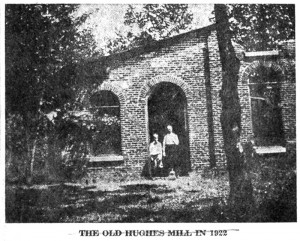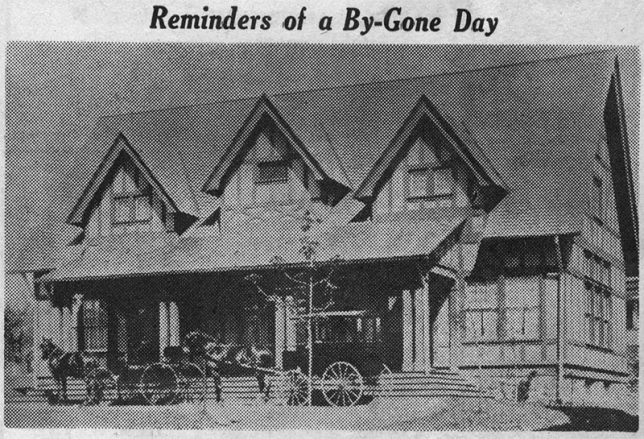A quaint landmark on the well travelled road that leads to Chester Valley by way of the Colonial Village Swimming Pool and Martin’s Dam Club is the small white stone house on old Upper Gulph road just at its intersection with Croton road.
Standing as it does among modern houses and remodeled old houses, the small whitewashed stone structure catches the eye of every passing motorist. So little changed during the 140 years it has stood there, it is, indeed, a quiet reminder of a day long past.
Until the house was sold in 1927 by James R. Wilds, of Wayne, to Sidney Evans Wells, it had been in the continuous possession of the Wilds family since the four acres of land, on which it originally stood, had been bought by John Wilds, and his sister, Sarah Wilds, in 1814. The old deed, still in the possession of the present James Wilds, shows that the purchase price was “150 silver milled dollars.”
The four acres were a portion of a large tract of land belonging to Rudolph Huzzard, a blacksmith, that extended as far west as Old Eagle School road. At a somewhat later date, this entire acreage could have been bought by John Wilds’ son for $1500.
The first Wilds to come to America was another James Wilds, the great – great – grandfather of the present James Wilds. When he left his native England, in 1772, he received a “certificate of good conduct” signed by the minister and “principal inhabitants” of the township of Crompton Parish, of Cresturick, County Palatine of Lancaster, showing that he left there “with unblemished character” and with the good wishes of his community. By trade he was a wool weaver, and probably worked in one of the old mills near King of Prussia after coming to America.
A son and daughter of this first James Wilds bought the four acres of land on old Upper Gulph road. Supposedly, they built the house that still stands there soon after they purchased the land, although there is no written record of the fact.
Here, John Wilds and his wife had a family of 15 children, though all did not live to maturity. The house then consisted of a basement kitchen, with two rooms above them on the second floor. It was not until the Wellses remodeled what appeared to be an old stone house that it was discovered that the original structure had probably been made of logs, at least in part.
In their remodeling the Wellses added eight feet to the west end of the house. At one time a barn, which has since been torn down, stood to the south of the house. So small and quaint and reminiscent of the past is this neat, white house, that it is difficult to believe that any changes at all have been made since it was built in about 1812. It is now the property of Mrs. Kathryn L. Stimson.
Across the road from the old Wilds’ homestead, in the northwest corner of Upper Gulph and Croton roads, is another old house now occupied by Mr. and Mrs. John H. Preston, Jr., who bought it from Mr. and Mrs. Arthur P. G. McGinnes. The latter is a descendant of the Hughes family, who at one time owned almost all of the houses on either side of Croton road, from Upper Gulph road to Martin’s Dam, in addition to the famous old Hughes’ lumber and grist mills. In reminiscing of her former home, Mrs. McGinnes tells of the original deep well, now part of the porch at the northwest corner of the house. In the course of remodeling it was discovered that this house, too, was, at least partly, made of logs.
A house dating back to the middle eighties is one on the left side of Croton road, past the Preston house. Now the property of Mr. and Mrs. Howard H. Stringer, it was originally built for Mr. and Mrs. William H. Owens. The former was a son of Sarah Hughes Owens. Sold to the Stringers by Mrs. John W. Henry, daughter of Mrs. Phoebe Hughes Brown, the original old white house has seen but few changes in its almost 70 years of existence, and none of them are of recent date.
Still another old house on Croton road is the one to the north of Miss Emily Exley’s, now occupied by Mr. and Mrs. George C. Turner. For many years this house was owned by William Morris. Across the road from the Exley and Turner properties is the former site of the old Indian School known as “Ponemah,” meaning “Land of Hereafter.”
In addition to what has been written in three previous issues of this column, this is in brief the story of historic Croton road, along which ran the rapidly flowing streams that turned the wheels of some of the famous mills on the edge of Chester Valley, none more famous than the old Hughes Mill described in last week’s column. Some time in the late 1700’s or early 1800’s a grist mill had been built near Zook’s Dam, later to be known as Martin’s Dam, then converted into one for the manufacture of woolen materials, and was sold to Richard Martin in 1841.
English born, the Martins had lived in Kensington before coming to Upper Merion township in Montgomery County to run a woolen mill such as they had owned in Kensington. They occupied a small pre – Revolutionary house across Croton road from the Dam. As the family grew, so did the house, until two wings had been added to it. All the Martin children, as they grew up, attended the small frame school on the right hand side of Croton road past Martin’s Dam, the walls of which are still standing. In winter they often went on stilts to keep out of the snow and in spring to keep out of the mud.
Of the nine children born to the Richard Martins, James was the last to occupy the old homestead. Some of the original acreage he sold to the Thomas Nurseries. In 1890 he sold the rights to Martin’s Dam and a few acres surrounding it to the Lower Merion Water Company. Whether the project was conceived in good faith has always been open to question. Certainly the flow of water was never great enough to warrant the piping of water to the lower Main Line, which was the announced purpose of the Company. So complicated was the title that it was not until 12 years after the organization of Martin’s Dam Club that the Directors were able to purchase the Dam.


